Submitted:
30 January 2024
Posted:
31 January 2024
You are already at the latest version
Abstract
Keywords:
1. Introduction
2. Results
2.1. Projected Changes in Temperature and Rainfall
| Scenarios | Rainfall (mm) | SD | Tmax (oC) | SD | Tmin (oC) | SD | Tmean (oC) | SD | ||
|---|---|---|---|---|---|---|---|---|---|---|
| Historical | GFDL-ESM2M | 743.28 | 143.99 | 27.76 | 3.60 | 14.69 | 4.18 | 21.22 | 3.46 | |
| MIROC-ESM | 824.69 | 181.91 | 27.86 | 3.70 | 14.75 | 4.12 | 21.31 | 3.45 | ||
| MPI-ESM-MR | 848.59 | 226.85 | 27.92 | 3.43 | 14.73 | 4.09 | 21.32 | 3.32 | ||
| Ensemble | 805.52 | 184.25 | 27.85 | 3.58 | 14.72 | 4.13 | 21.28 | 3.41 | ||
| RCP4.5 | GFDL-ESM2M | 2025 | 914.91 | 28.92 | 15.53 | 22.22 | ||||
| MIROC-ESM | 2025 | 713.16 | 27.80 | 17.01 | 22.41 | |||||
| MPI-ESM-MR | 2025 | 835.40 | 28.72 | 15.22 | 21.97 | |||||
| Ensemble* | 821.16* | 28.48* | 15.92 | 22.20 | ||||||
| GFDL-ESM2M | 2055 | 1,021.93 | 29.38 | 15.71 | 22.55 | |||||
| MIROC-ESM | 2055 | 730.12 | 27.04 | 17.08 | 22.06 | |||||
| MPI-ESM-MR | 2055 | 868.33 | 29.58 | 15.71 | 22.65 | |||||
| Ensemble | 873.46 | 28.66 | 16.17 | 22.42 | ||||||
| GFDL-ESM2M | 2085 | 929.44 | 29.77 | 15.91 | 22.84 | |||||
| MIROC-ESM | 2085 | 788.55 | 26.20 | 17.11 | 21.66 | |||||
| MPI-ESM-MR | 2085 | 801.61 | 29.85 | 15.82 | 22.83 | |||||
| Ensemble | 839.87 | 28.61 | 16.28 | 22.44 | ||||||
| RCP8.5 | GFDL-ESM2M | 2025 | 841.52 | 28.88 | 15.39 | 22.14 | ||||
| MIROC-ESM | 2025 | 721.98 | 27.75 | 17.02 | 22.38 | |||||
| MPI-ESM-MR | 2025 | 829.40 | 28.96 | 15.36 | 22.16 | |||||
| Ensemble | 797.64 | 28.53 | 15.92 | 22.23 | ||||||
| GFDL-ESM2M | 2055 | 875.60 | 29.93 | 15.88 | 22.90 | |||||
| MIROC-ESM | 2055 | 821.06 | 26.21 | 17.12 | 21.66 | |||||
| MPI-ESM-MR | 2055 | 764.61 | 29.98 | 15.91 | 22.95 | |||||
| Ensemble | 820.42 | 28.71 | 16.30 | 22.51 | ||||||
| GFDL-ESM2M | 2085 | 426.43 | 30.91 | 16.86 | 23.89 | |||||
| MIROC-ESM | 2085 | 943.07 | 24.83 | 17.11 | 20.97 | |||||
| MPI-ESM-MR | 2085 | 382.62 | 30.71 | 16.78 | 23.74 | |||||
| Ensemble | 584.04 | 28.82 | 16.92 | 22.87 |
| RCP4.5 | RCP8.5 | |||||
|---|---|---|---|---|---|---|
| 2010-2039 | 2040-2069 | 2070-2099 | 2010-2039 | 2040-2069 | 2070-2099 | |
| Rainfall (mm) | 15.64 | 67.94 | 34.35 | -7.88 | 14.91 | -221.48 |
| Tmax (oC) | 0.64 | 0.82 | 0.97 | 0.69 | 0.86 | 0.97 |
| Tmin (oC) | 1.20 | 1.45 | 1.56 | 1.20 | 1.58 | 2.20 |
| Tmean (oC) | 0.92 | 1.13 | 1.16 | 0.94 | 1.22 | 1.58 |
| Rainfall % change | 1.94 | 8.43 | -27.49 | -0.98 | 1.85 | -27.49 |
2.2. Probability Distribution Functions (PDFs) for Rainfall and Temperature
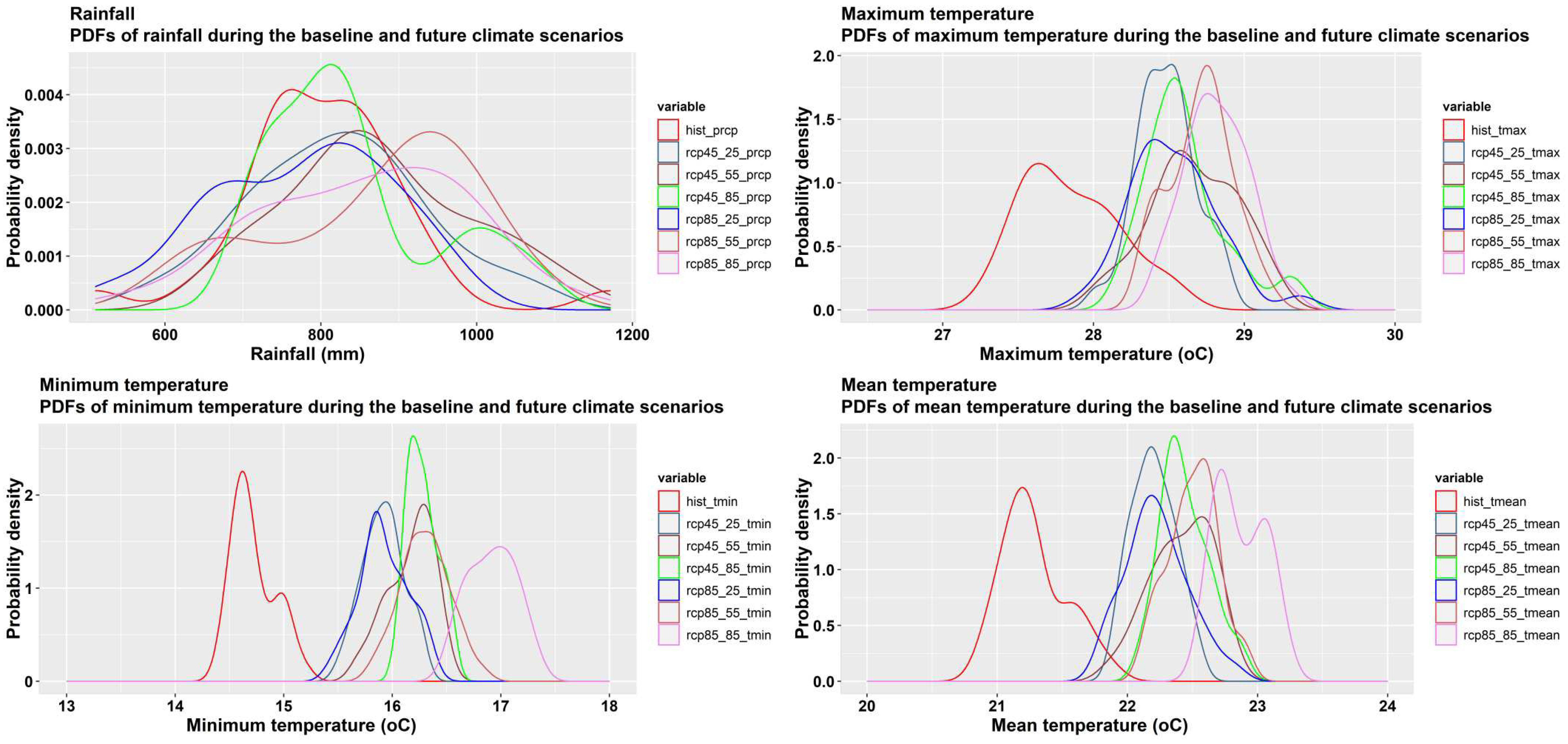
2.3. Biophysical Analysis of Maize Yield
| Mean Grain Yield | Grain Yield under RCP4.5 | Grain Yield under RCP8.5 | |||||||
|---|---|---|---|---|---|---|---|---|---|
| 1971-2000 | SD | 2025 | 2055 | 2085 | 2025 | 2055 | 2085 | ||
| 1 | SD1_v1n1 | 4402 | 342 | 4492.8 | 4550.87 | 4440.33 | 4854.73 | 4634.43 | 4787.07 |
| 2 | SD1_v1n2 | 5849 | 659 | 5725.23 | 5374.3 | 5369.93 | 5979.1 | 6089.23 | 6222.07 |
| 3 | SD1_v1n3 | 5658 | 715 | 5051.93 | 5192.9 | 5264.9 | 6948.53 | 6906.63 | 6819.9 |
| 4 | SD2_v1n1 | 4456 | 210 | 4086.8 | 4006.17 | 3984.43 | 4197.43 | 4285.73 | 4140.3 |
| 5 | SD2_v1n2 | 5877 | 790 | 5610.37 | 5889.6 | 5518.43 | 5916.03 | 5738.77 | 5915.73 |
| 6 | SD2_v1n3 | 5392 | 653 | 5493.67 | 5693.17 | 5465.83 | 6805.20* | 6926.00* | 7138.37* |
| 7 | SD3_v1n1 | 3392 | 538 | 4170.83 | 4270.5 | 4138.63 | 4403.13 | 4312.2 | 4422.2 |
| 8 | SD3_v1n2 | 5831 | 901 | 5378.17 | 5412.3 | 5345.7 | 5914.73 | 5693 | 5981 |
| 9 | SD3_v1n3 | 5094 | 627 | 4860.53 | 5011 | 5051.4 | 6702.10* | 6532.70* | 6683.80* |
| 10 | SD1_v2n1 | 3970 | 281 | 4212.4 | 4308.67 | 4216.73 | 3932.2 | 3989.1 | 4161.67 |
| 11 | SD1_v2n2 | 5854 | 465 | 5750.33 | 5419.97 | 5366.33 | 6210.07 | 6266.9 | 6354.5 |
| 12 | SD1_v2n3 | 5789 | 824 | 4847.03 | 5013.23 | 5098.27 | 7140.3 | 7086.5 | 7019.13 |
| 13 | SD2_v2n1 | 4111 | 266 | 4188.3 | 4151.97 | 4066.7 | 3949.83 | 4003.87 | 3972.5 |
| 14 | SD2_v2n2 | 5984 | 405 | 5696.13 | 5911.73 | 5683.23 | 6035.3 | 5991.7 | 6025.67 |
| 15 | SD2_v2n3 | 5562 | 807 | 5352.23 | 5520.13 | 5330.9 | 6868.17 | 6959.17 | 7171.57 |
| 16 | SD3_v2n1 | 4150 | 322 | 4139.07 | 4224.8 | 4193.5 | 3862.8 | 4036.03 | 4028.33 |
| 17 | SD3_v2n2 | 6160 | 404 | 5370.5 | 5401.17 | 5378.83 | 6087.9 | 5872.53 | 6105.67 |
| 18 | SD3_v2n3 | 5422 | 792 | 4688.43 | 4879.4 | 4879.63 | 6784.97 | 6613.13 | 6806.97 |
| 19 | SD1_v3n1 | 4121 | 223 | 2982.47 | 3075.27 | 3026.1 | 1822.13 | 1756.6 | 1903.2 |
| 20 | SD1_v3n2 | 5690 | 637 | 5691.43 | 5306.07 | 5298.1 | 6239.23 | 6194.77 | 6402.47 |
| 21 | SD1_v3n3 | 5523 | 894 | 4701.03 | 4836.37 | 4916.3 | 7195.73 | 7094.17 | 7071.27 |
| 22 | SD2_v3n1 | 4289 | 234 | 4196.5 | 4325.53 | 4148.13 | 3481.53 | 3358.13 | 3400.87 |
| 23 | SD2_v3n2 | 5676 | 697 | 5895.93 | 6041.3 | 5765.43 | 6373.37 | 6208.4 | 6321.63 |
| 24 | SD2_v3n3 | 5308 | 854 | 5265.97 | 5397.83 | 5293.93 | 6957.1 | 7003.3 | 7244.53* |
| 25 | SD3_v3n1 | 3931 | 436 | 3433.6 | 3403.5 | 3717.13 | 1891.8 | 2048 | 2106.73 |
| 26 | SD3_v3n2 | 5766 | 752 | 5379.53 | 5421.73 | 5474.4 | 6288.17 | 5992.77 | 6510.1 |
| 27 | SD3_v3n3 | 5087 | 785 | 4543.07 | 4777.17 | 4762.8 | 6801.9 | 6661.40 | 6831.27* |
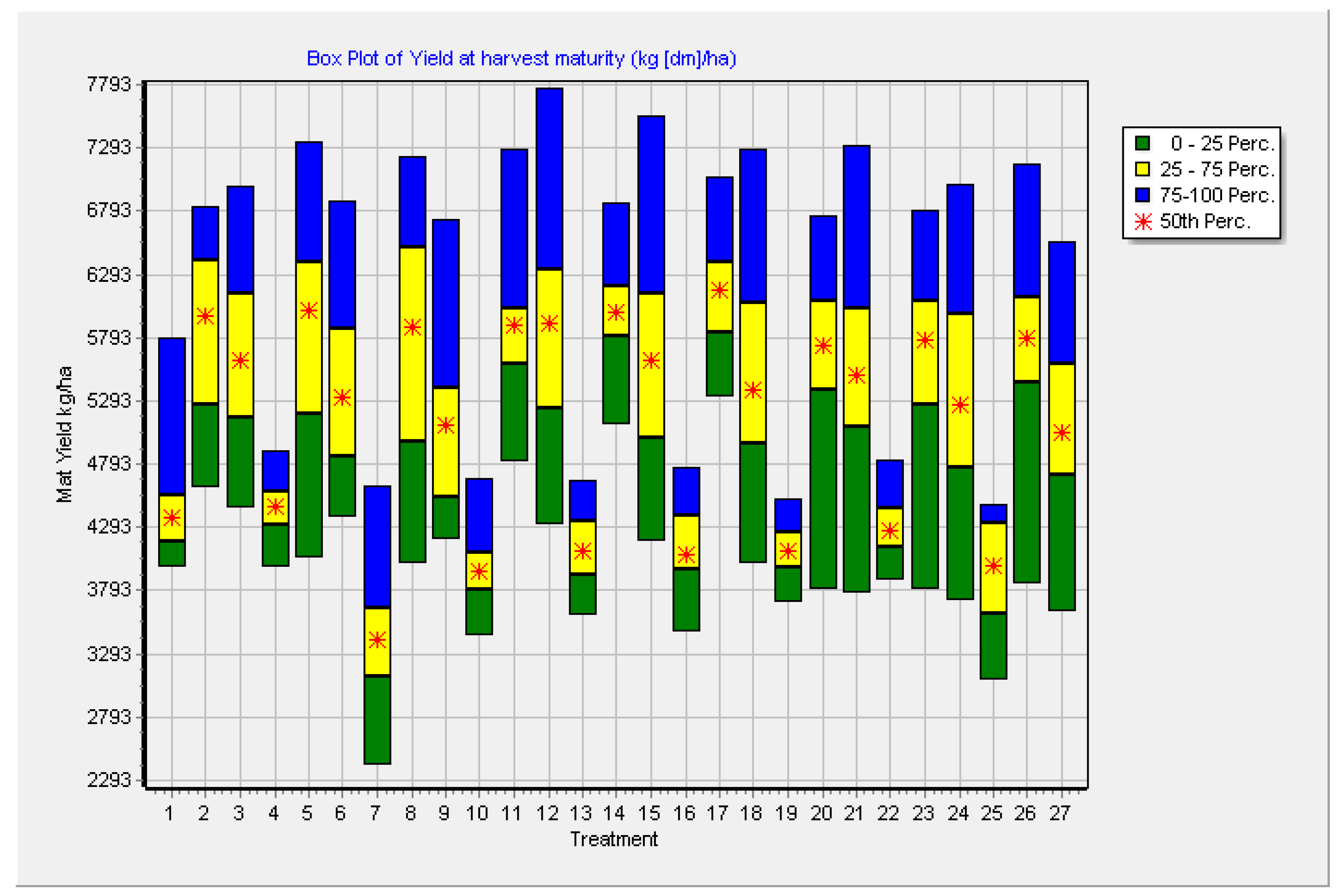
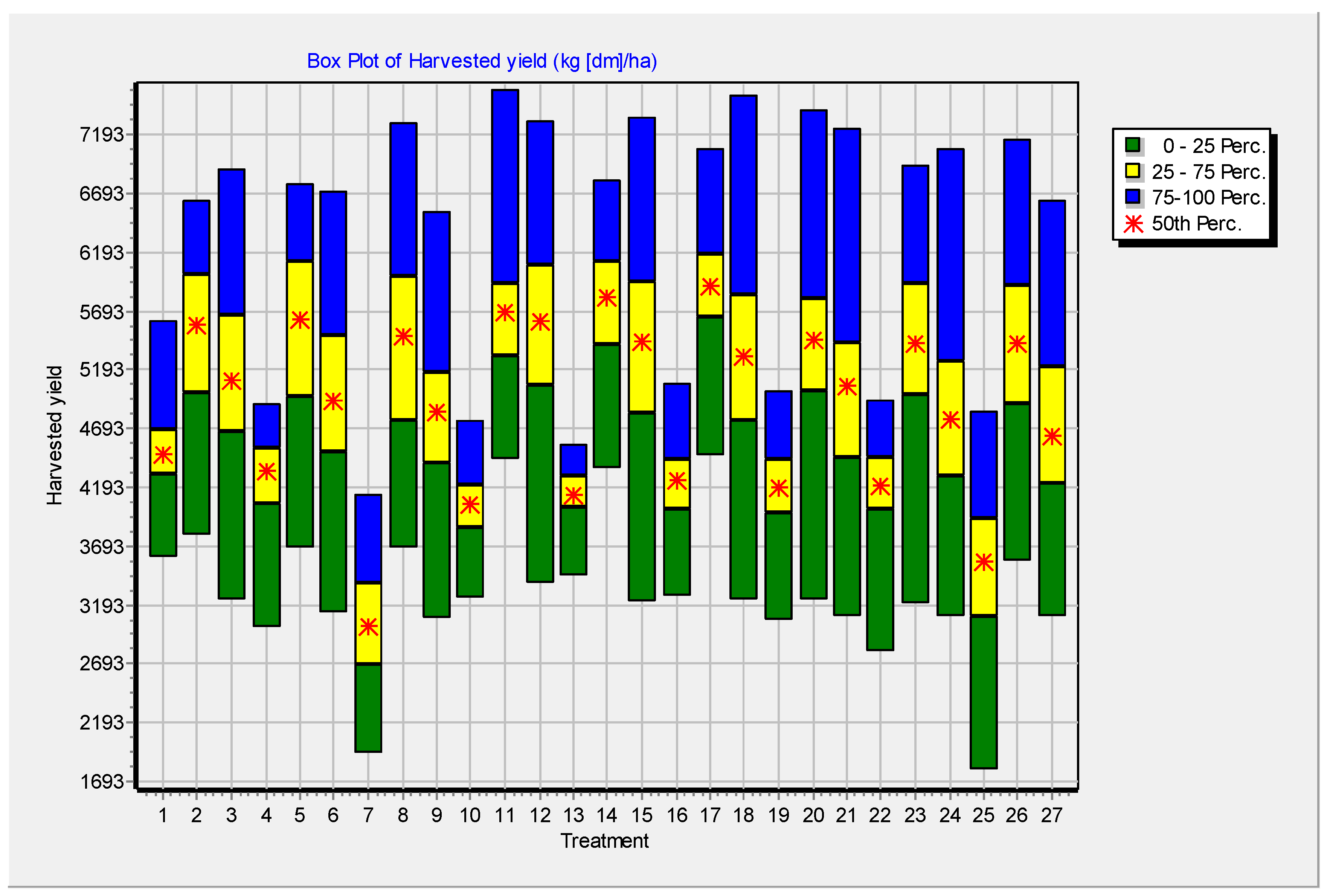
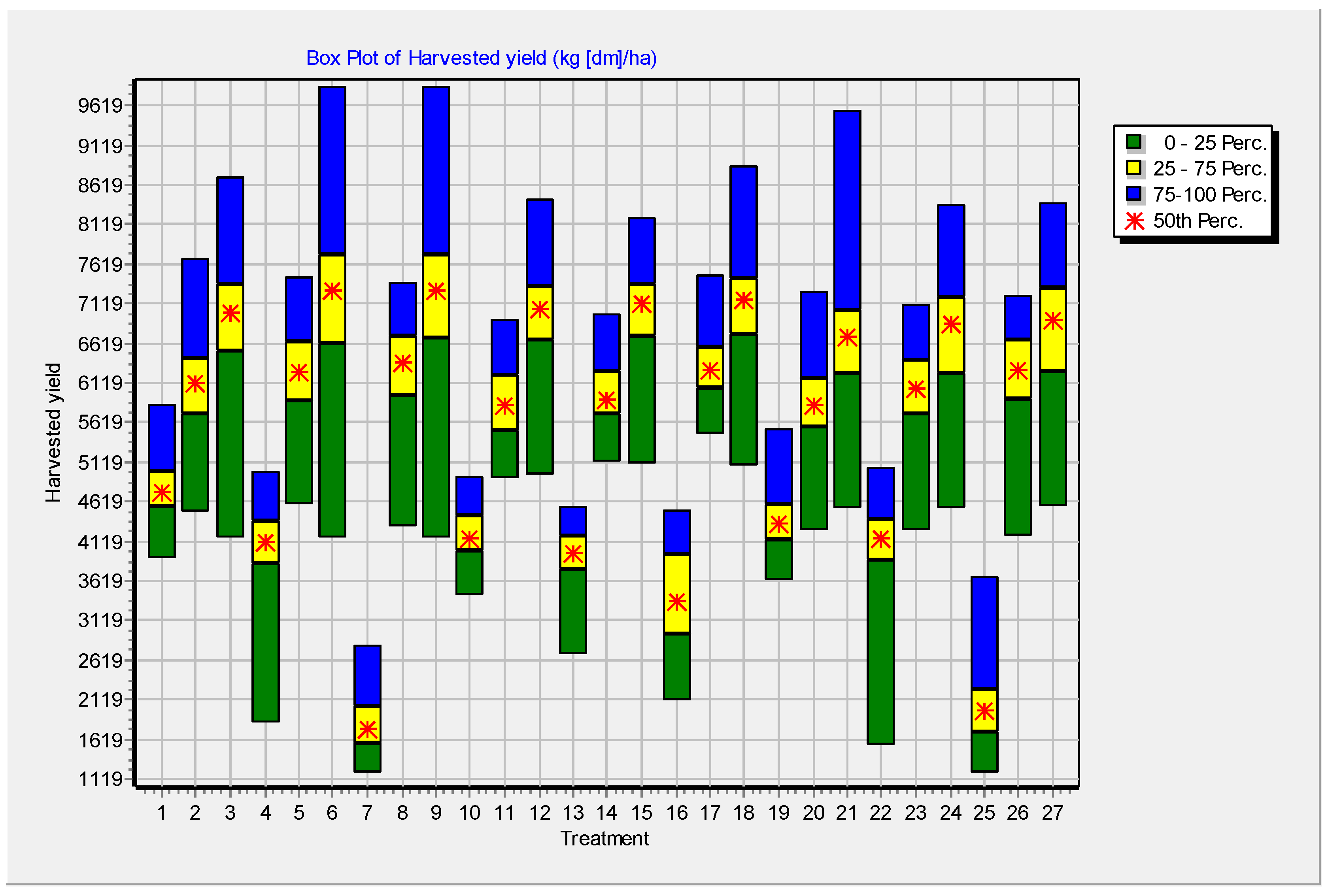
2.4. Economic and Strategic Analysis
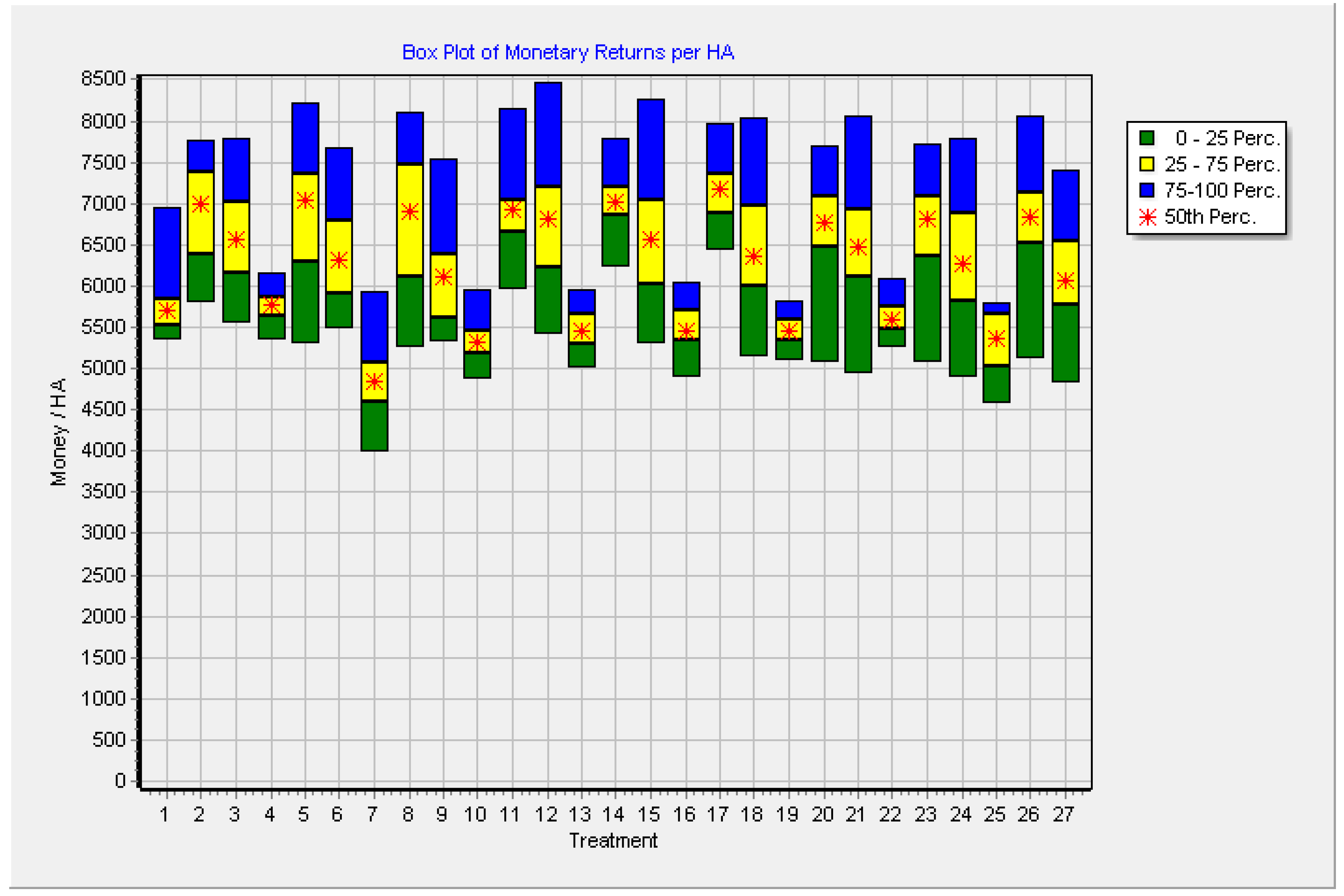
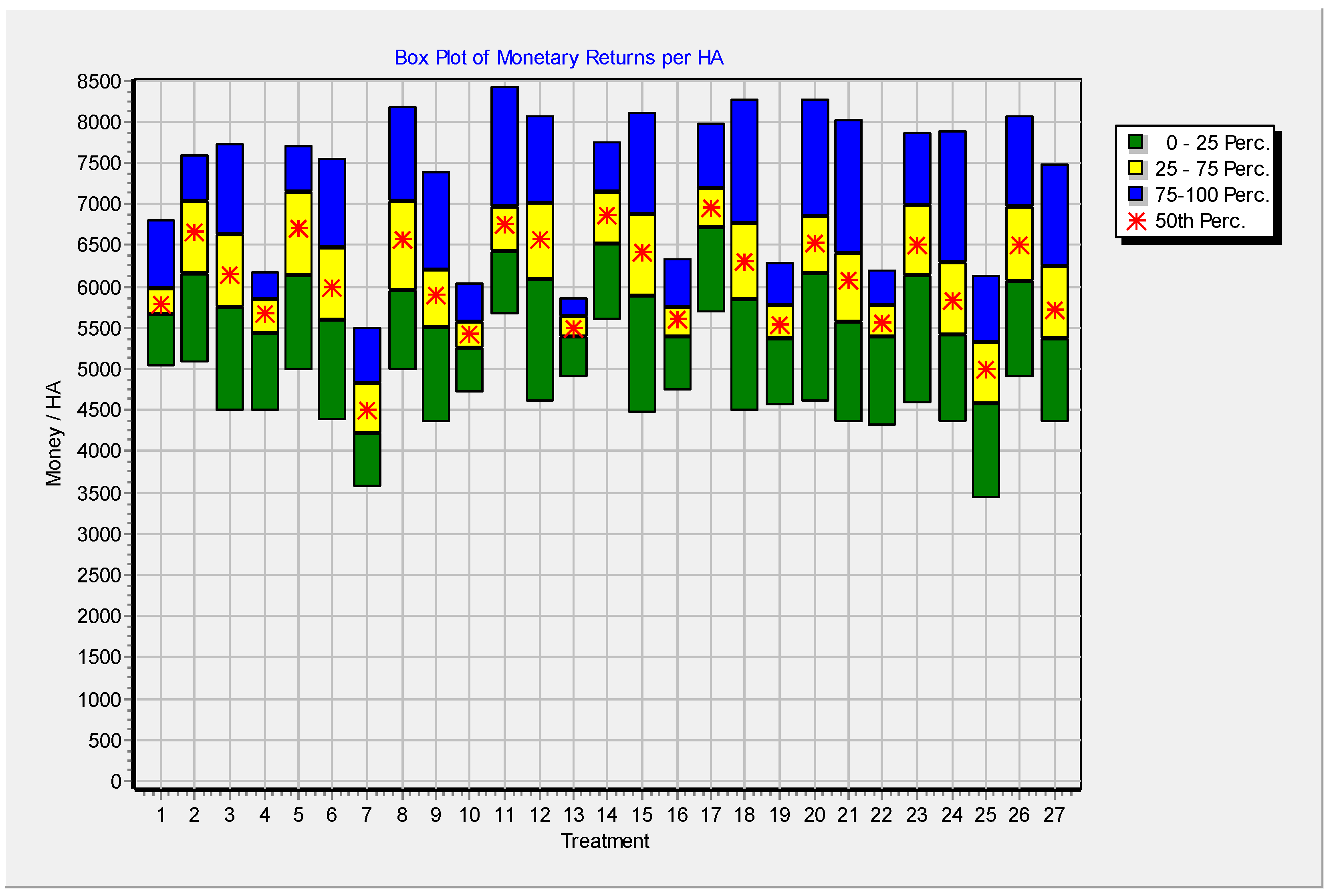
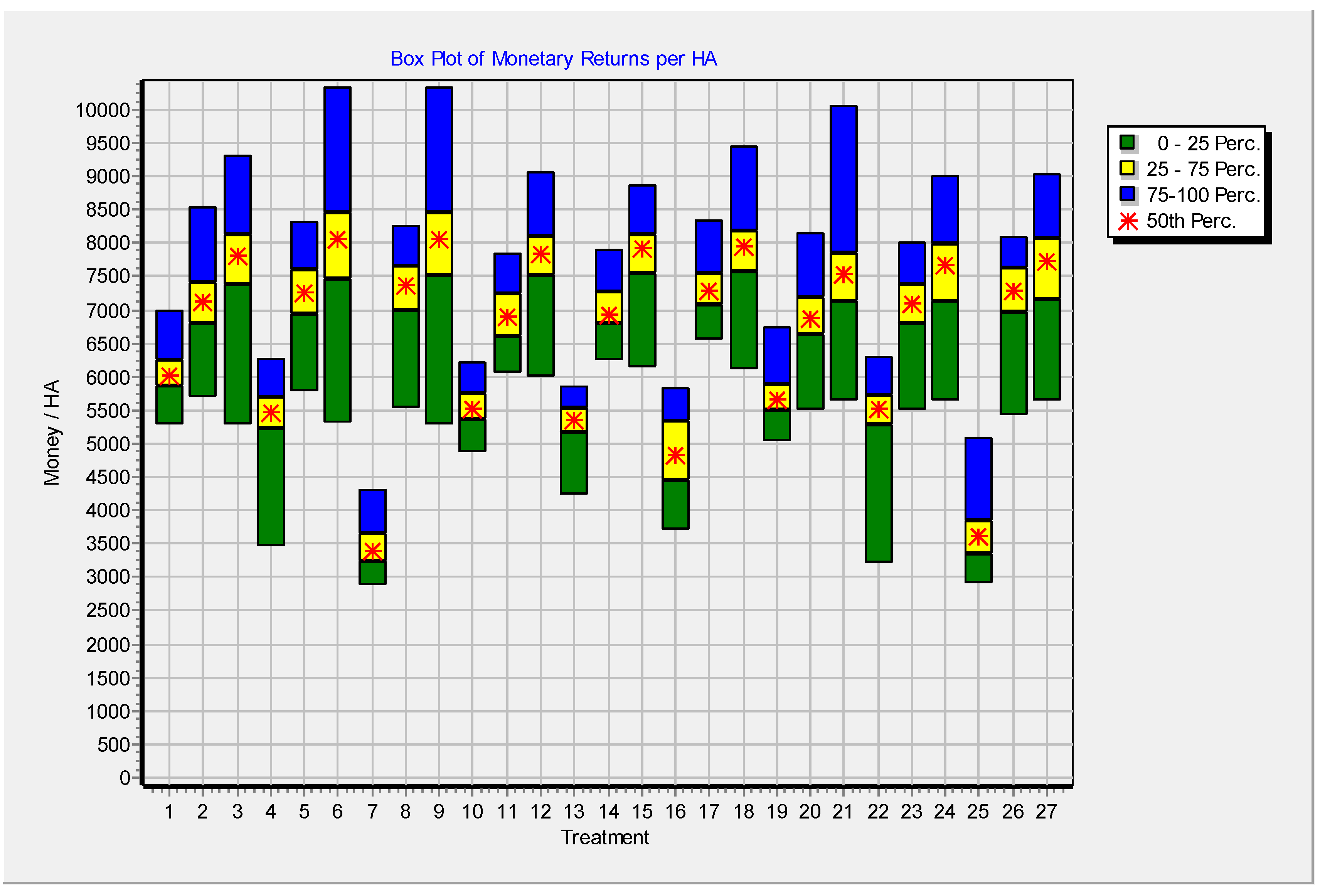
| Historical | RCP4.5 | RCP8.5 | |||||||||
|---|---|---|---|---|---|---|---|---|---|---|---|
| Treatment | Cultivar | E(x) | E(x) - F(x) | Efficient | E(x) | E(x) - F(x) | Efficient | E(x) | E(x) - F(x) | Efficient | |
| 1 | SD1N1 | 30G19 | 5711.2 | 5561.9 | No | 5813.9 | 5643.1 | No | 6046.4 | 5873.8 | No |
| 2 | SD1N2 | 30G19 | 6856.9 | 6525.1 | No | 6581.8 | 6252.6 | No | 7117.1 | 6856.4 | No |
| 3 | SD1N3 | 30G19 | 6556.4 | 6189.5 | No | 6188.4 | 5797.1 | No | 7708.1 | 7290.4 | No |
| 4 | SD2N1 | 30G19 | 5758.6 | 5652.9 | No | 5594.3 | 5401.4 | No | 5400.9 | 5141.4 | No |
| 5 | SD2N2 | 30G19 | 6881.5 | 6486 | No | 6601.5 | 6240.3 | No | 7276.3 | 7017.6 | No |
| 6 | SD2N3 | 30G19 | 6321.5 | 5986.6 | No | 6026.2 | 5638.7 | No | 7876.1 | 7411.5 | No |
| 7 | SD3N1 | 30G19 | 4831.4 | 4561.6 | No | 4518.8 | 4283 | No | 3458 | 3275.6 | No |
| 8 | SD3N2 | 30G19 | 6840.7 | 6381.1 | No | 6530.6 | 6101.4 | No | 7277.8 | 6968.8 | No |
| 9 | SD3N3* | 30G19* | 6058.1 | 5742.4 | No | 5877.6 | 5520.3 | No | 7910* | 7447.4* | Yes* |
| 10 | SD1N1 | 30B50 | 5329.1 | 5190.5 | No | 5399.9 | 5257.1 | No | 5560 | 5415.6 | No |
| 11 | SD1N2 | 30B50 | 6860.7 | 6636.6 | No | 6743.3 | 6473.5 | No | 6905.2 | 6665.4 | No |
| 12 | SD1N3 | 30B50 | 6672.1 | 6255.6 | No | 6524.8 | 6160.8 | No | 7765.3 | 7450.4 | No |
| 13 | SD2N1 | 30B50 | 5453.8 | 5317.4 | No | 5496.9 | 5382.1 | No | 5354.7 | 5205.5 | No |
| 14 | SD2N2 | 30B50 | 6975.8 | 6774.2 | No | 6823.6 | 6555.2 | No | 7047.1 | 6827.5 | No |
| 15 | SD2N3 | 30B50 | 6470.9 | 6062.7 | No | 6392.5 | 6020 | No | 7803.4 | 7492.3 | No |
| 16 | SD3N1 | 30B50 | 5500.7 | 5338.4 | No | 5574.4 | 5429.5 | No | 4858.6 | 4564.3 | No |
| 17 | SD3N2 | 30B50 | 7131.6 | 6928.2 | Yes | 6944.7 | 6719.3 | Yes | 7297.5 | 7103.2 | No |
| 18 | SD3N3 | 30B50 | 6347.5 | 5945.9 | No | 6320.3 | 5951.8 | No | 7864 | 7534.6 | Yes |
| 19 | SD1N1 | ZMS606 | 5462.6 | 5349.1 | No | 5547.8 | 5369.2 | No | 5711.3 | 5530 | No |
| 20 | SD1N2 | ZMS606 | 6716.6 | 6404.7 | No | 6483.7 | 6144.3 | No | 6910.5 | 6656.4 | No |
| 21 | SD1N3 | ZMS606 | 6437 | 5982.8 | No | 6015.7 | 5640.2 | No | 7485.4 | 7125.3 | No |
| 22 | SD2N1 | ZMS606 | 5611.6 | 5493.5 | No | 5541.2 | 5351.7 | No | 5355 | 5030.4 | No |
| 23 | SD2N2 | ZMS606 | 6704 | 6355.9 | No | 6487.9 | 6123.7 | No | 7051 | 6793.6 | No |
| 24 | SD2N3 | ZMS606 | 6246.6 | 5812.3 | No | 5875.7 | 5501.6 | No | 7569.7 | 7193.1 | No |
| 25 | SD3N1 | ZMS606 | 5306.7 | 5084.9 | No | 4951.6 | 4639.1 | No | 3624.2 | 3390.7 | No |
| 26 | SD3N2 | ZMS606 | 6783.2 | 6409.3 | No | 6524.7 | 6129.4 | No | 7264.4 | 6997.8 | No |
| 27 | SD3N3 | ZMS606 | 6051.5 | 5651.3 | No | 5768.5 | 5406.4 | No | 7596.1 | 7206.4 | No |
3. Discussion
3.1. Projected Changes in Tmax, Tmin and Rainfall
3.2. Probability Distribution Functions (PDFs) for rainfall, Tmax and Tmin
3.3. Biophysical Analysis of Maize Yield
3.4. Economic and Strategic Analysis
4. Materials and Methods
4.1. Experimental Site
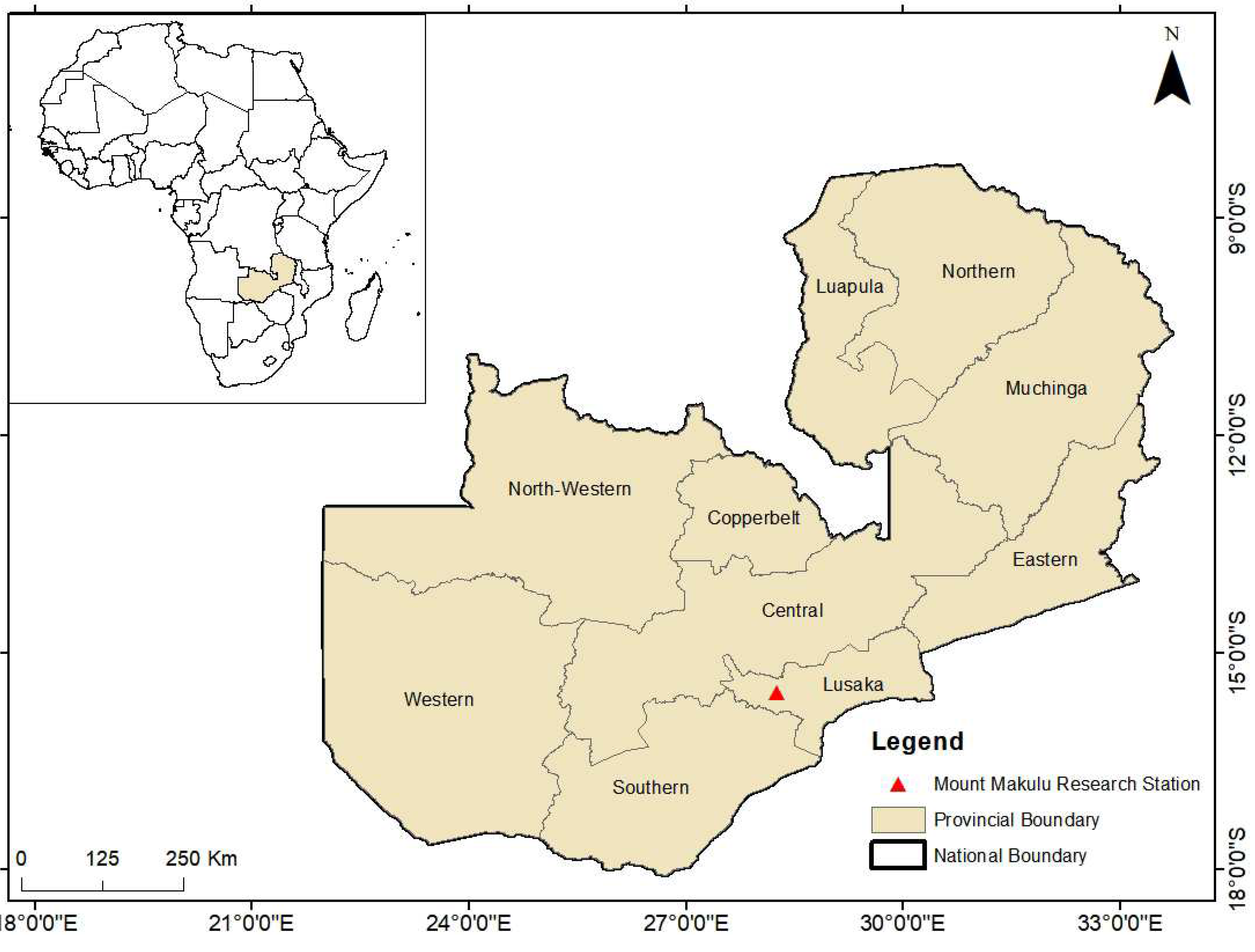
4.2. Field Experiment
4.3. Climate Input Data
| Model | Modeling Centre | Resolution | Reference |
|---|---|---|---|
| GFDL-ESM2M | Geophysical Fluid Dynamics Laboratory | 2.5ox2.5o | [46,52] |
| MIROC-ESM | Atmosphere and Ocean Research Institute (University of Tokyo), National Institute for Environmental Studies and Japan Agency for Marine-Earth Science and Technology | 2.8o x 2.8o | [46,50,56] |
| MPI-ESM-MR | Max Planck Institute for Meteorology (MPI-M) | 1.87ox1.87o | [46,54,57] |
4.4. Solar Radiation Input Data
4.5. Planting Materials and Treatments
4.6. Decision Support System for Agro-technology Transfer (DSSAT) Model
| Depth (cm) | 0-20 | 20-40 | 40-60 | 60-80 | 80-100 | Analysis method |
|---|---|---|---|---|---|---|
| pH (water) | 7.30 | 7.20 | 7.50 | 7.70 | 7.60 | 1:5 soil water |
| Total N (%) | 0.031 | 0.042 | 0.054 | 0.061 | 0.036 | Modified Kjeldahl method |
| NO3N | 29.90 | 48.70 | 56.40 | 70.10 | 42.80 | |
| NH4N | 18.00 | 29.20 | 33.90 | 42.10 | 25.70 | |
| P extractable (mg kg-1) | 10.00 | 11.00 | 10.00 | 18.00 | 12.00 | Bray 1 |
| K (mg kg1) | 1.05 | 0.99 | 1.12 | 0.59 | 0.89 | Ammonium acetate |
| Ca (cmol(+) kg-1) | 11.00 | 9.30 | 3.40 | 2.90 | 3.20 | Ammonium acetate |
| Mg (cmol(+) kg-1) | 3.50 | 2.70 | 2.30 | 1.00 | 1.30 | Ammonium acetate |
| OC (%) | 0.35 | 0.57 | 0.66 | 0.82 | 0.50 | Walkley & Black method |
| OM (%) | 0.602 | 0.980 | 1.135 | 1.410 | 0.860 | |
| CEC (cmol(+) kg-1) | 15.57 | 13.02 | 6.85 | 4.52 | 5.42 | Ammonium acetate |
| Bulk density (g cm-3) | 1.43 | 1.41 | 1.41 | 1.46 | 1.36 | SPAW |
| Silt (%) | 12.80 | 16.80 | 12.80 | 18.80 | 2.80 | Hydrometer method |
| Sand (%) | 39.60 | 35.60 | 37.60 | 41.60 | 37.60 | |
| Clay (%) | 47.60 | 47.60 | 49.60 | 39.60 | 59.60 | |
| Soil texture | clay | clay | clay | clay | clay | SPAW |
| LL | 0.287 | 0.287 | 0.299 | 0.244 | 0.350 | SPAW |
| DUL | 0.407 | 0.409 | 0.419 | 0.363 | 0.470 | |
| SAT | 0.459 | 0.467 | 0.468 | 0.447 | 0.487 | |
| SHC (mm h-1) | 0.350 | 0.500 | 0.290 | 1.480 | 0.010 |
| Parameter | Explanation | Units | ZMS 606 | PHB 30G19 | PHB 30B50 |
|---|---|---|---|---|---|
| P1 | GDDs (based on 8oC) from emergence to end of juvenile phase | ℃d | 159.00 | 209.90 | 155.10 |
| P2 | Photoperiod sensitivity coefficient (01.0) | 1.895 | 0.441 | 1.7630 | |
| P5 | GDDs (based on 8oC) from silking to maturity | ℃d | 810.20 | 815.90 | 800.40 |
| G2 | Maximum possible number of kernels per plant | 945.00 | 840.80 | 795.60 | |
| G3 | Potential kernel growth rate (mg day-1) | mg day-1 | 8.559 | 8.840 | 15.340 |
| PHINT | GDDs required for a leaf tip to appear(based on 8oC) | ℃d | 59.70 | 56.08 | 59.73 |
4.7. Change in Rainfall and Temperature
4.8. Long-Term Simulation Experiments
4.9. Economic Analysis
| Description | Unit | Value (USD) |
|---|---|---|
| Grain price | $/t | 883.00 |
| Harvest by-product | $/t | 0.00 |
| Base production costs | $/ha | 155 |
| N fertilizer cost | $/kg | 1.68 |
| N cost / application | $ | 33.00 |
| Irrigation cost | $/mm | 0.00 |
| Irr cost / application | $ | 0.00 |
| Seed cost | $/kg | 22.00 |
| Organic amendments | $/t | 0.00 |
| P fertilizer cost | $/kg | 0.00 |
| P cost / application | $ | 0.00 |
| K fertilizer cost | $/kg | 0.00 |
| K cost / application | $ | 0.00 |
4.10. Statistics Analysis
4.11. Contribution to the Field Statement
Funding
Acknowledgments
Conflicts of Interest
References
- C.B. Chisanga, M. Moombe, E. Phiri, Modelling climate change impacts on maize, CABI Rev. 2022 (2022) 11. [CrossRef]
- C. Zhao, B. Liu, S. Piao, X. Wang, D.B. Lobell, Y. Huang, M. Huang, Y. Yao, S. Bassu, P. Ciais, J.-L. Durand, J. Elliott, F. Ewert, I.A. Janssens, T. Li, E. Lin, Q. Liu, P. Martre, C. Müller, S. Peng, J. Peñuelas, A.C. Ruane, D. Wallach, T. Wang, D. Wu, Z. Liu, Y. Zhu, Z. Zhu, S. Asseng, Temperature increase reduces global yields of major crops in four independent estimates, Proc. Natl. Acad. Sci. 114 (2017) 9326–9331. [CrossRef]
- B. Parkes, D. B. Parkes, D. Defrance, B. Sultan, P. Ciais, X. Wang, C. Ben Parkes, Projected changes in crop yield mean and variability over West Africa in a world 1.5 K warmer than the pre-industrial era, Earth Syst. Dyn. 9 (2018) 119–134. [CrossRef]
- S. Liu, J. Yang, X. Yang, C.F. Drury, R. Jiang, W. Daniel Reynolds, Simulating maize yield at county scale in southern Ontario using the decision support system for agrotechnology transfer model, Can. J. Soil Sci. 101 (2021) 734–748. [CrossRef]
- C.B. Chisanga, Interactive effects of N fertilization rate, cultivars and planting date under climate change on maize (Zea mays L.) yield using crop simulation and statistical downscaling of climate models, University of Zambia, Lusaka, Zambia, 2019.
- Q.A. Seko, V. Jongrungrot, Economic modelling and simulation analysis of maize-based smallholder farming systems in the Senqu River Valley agroecological zone, Lesotho, Cogent Food Agric. 8 (2022) 19. [CrossRef]
- C.B. Chisanga, E. Phiri, C. Shepande, Effect of planting date and nitrogen application rate on maize (Zea mays L.) growth and yield in Lusaka, Zambia, Zambian J. Agric. Sci. 9 (2014) 64–70.
- C.B. Chisanga, Evaluation of the CERES-Maize model in simulating maize (Zea mays L.) growth, development and yield at different planting dates and nitrogen rates in a subtropical environment of Zambia, The University of Zambia, 2014.
- M. Buriro, T.A. Bhutto, A.W. Gandahi, I.A. Kumbhar, M.U. Shar, Effect of Sowing Dates on Growth, Yield and Grain Quality of Hybrid Maize, J. Basic Appl. Sci. 11 (2015) 553–558. [CrossRef]
- X. X.P. Chen, F.S. Zhang, Z.L. Cui, F. Li, J.L. Li, Optimizing Soil Nitrogen Supply in the Root Zone to Improve Maize Management, Soil Sci. Soc. Am. J. 74 (2010) 1367–1373. [CrossRef]
- S. Liu, J.Y. Yang, X.Y. Zhang, C.F. Drury, W.D. Reynolds, G. Hoogenboom, Modelling crop yield, soil water content and soil temperature for a soybean–maize rotation under conventional and conservation tillage systems in Northeast China, Agric. Water Manag. 123 (2013) 32–44. [CrossRef]
- H. LIU, J. YANG, P. HE, Y. BAI, J. JIN, C.F. Drury, Y. ZHU, X. YANG, W. LI, J. XIE, J. YANG, G. Hoogenboom, Optimizing Parameters of CSM-CERES-Maize Model to Improve Simulation Performance of Maize Growth and Nitrogen Uptake in Northeast China, J. Integr. Agric. 11 (2012) 1898–1913. [CrossRef]
- M. Ahmed, Fayyaz-ul-Hassan, APSIM and DSSAT models as decision support tools, in: 19th Int. Congr. Model. Simulation, Perth, 12–16 December 2011, Perth, Australia, 2011: pp. 1174–1180.
- B.T. Kassie, S. Asseng, C.H. Porter, F.S. Royce, Performance of DSSAT-Nwheat across a wide range of current and future growing conditions, Eur. J. Agron. 81 (2016) 27–36. [CrossRef]
- A.M. Manschadi, J. Eitzinger, M. Breisch, W. Fuchs, T. Neubauer, A. Soltani, Full Parameterisation Matters for the Best Performance of Crop Models: Inter-comparison of a Simple and a Detailed Maize Model, Int. J. Plant Prod. 15 (2021) 61–78. [CrossRef]
- H. LIU, H. LIU, Q. LEI, L. ZHAI, H. WANG, J. ZHANG, Y. ZHU, S. LIU, S. LI, J. ZHANG, X. LIU, Using the DSSAT model to simulate wheat yield and soil organic carbon under a wheat-maize cropping system in the North China Plain, J. Integr. Agric. 16 (2017) 2300–2307. [CrossRef]
- C.B. Chisanga, E. Phiri, V.R.N. Chinene, L.M. Chabala, Projecting maize yield under local-scale climate change scenarios using crop models: Sensitivity to sowing dates, cultivar, and nitrogen fertilizer rates, Food Energy Secur. 9 (2020) 1–17. [CrossRef]
- C.B. Chisanga, E. Phiri, V.R.N. Chinene, Reliability of Rain-Fed Maize Yield Simulation Using LARS-WG Derived CMIP5 Climate Data at Mount Makulu, Zambia, J. Agric. Sci. 12 (2020) 275. [CrossRef]
- C.B. Chisanga, E. Phiri, V.R.N. Chinene, Evaluating APSIM-and-DSSAT-CERES-Maize Models under Rainfed Conditions Using Zambian Rainfed Maize Cultivars, Nitrogen. 2 (2021) 392–414. [CrossRef]
- Hoogenboom, E. Luedeling, K.M. Hadgu, I. Kisekka, L.G. Martorano, Assessment of maize growth and yield using crop models under present and future climate in southwestern Ethiopia, Agric. For. Meteorol. 214 (2015) 252–265. [CrossRef]
- M. Ahmed, M.N. Akram, M. Asim, M. Aslam, F. Hassan, S. Higgins, C.O. Stöckle, G. Hoogenboom, Calibration and validation of APSIM-Wheat and CERES-Wheat for spring wheat under rainfed conditions: Models evaluation and application, Comput. Electron. Agric. 123 (2016) 384–401. [CrossRef]
- H.L. Liu, J.Y. Yang, C.F. Drury, W.D. Reynolds, C.S. Tan, Y.L. Bai, P. He, J. Jin, G. Hoogenboom, Using the DSSAT-CERES-Maize model to simulate crop yield and nitrogen cycling in fields under long-term continuous maize production, Nutr. Cycl. Agroecosystems. 89 (2011) 313–328. [CrossRef]
- P.G. Tovihoudji, P.B.I. Akponikpè, E.K. Agbossou, C.L. Bielders, Using the DSSAT Model to Support Decision Making Regarding Fertilizer Microdosing for Maize Production in the Sub-humid Region of Benin, Front. Environ. Sci. 7 (2019) 1–15. [CrossRef]
- B.K. Kogo, L. Kumar, R. Koech, P. Langat, Modelling Impacts of Climate Change on Maize (Zea mays L.) Growth and Productivity: A Review of Models, Outputs and Limitations, J. Geosci. Environ. Prot. 07 (2019) 76–95. [CrossRef]
- S.A. Ouda, T. Noreldin, O. Mounzer, M.T. Abdelhamid, CropSyst model for wheat irrigation water management with fresh and poor quality water, J. Water L. Dev. (2015) 1429–7426. [CrossRef]
- 26. J.W. Jones, G. Hoogenboom, C.H. Porter, K.J. Boote, W.D. Batchelor, L.A. Hunt, P.W. Wilkens, U. Singh, A.J. Gijsman, J.T. Ritchie, The DSSAT cropping system model, Eur. J. Agron. 18 (2003) 235–265. [CrossRef]
- M.A. Iqbal, Y. Shen, R. Stricevic, H. Pei, H. Sun, E. Amiri, A. Penas, S. del Rio, Evaluation of the FAO AquaCrop model for winter wheat on the North China Plain under deficit irrigation from field experiment to regional yield simulation, Agric. Water Manag. 135 (2014) 61–72. [CrossRef]
- Y.G. Beletse, W. Durand, C. Nhemachena, Projected Impacts of Climate Change Scenarios on the Production of Maize in Southern Africa : An Integrated Assessment Case Study of the Bethlehem District, Central Free State, South Africa, in: Handb. Clim. Chang. AGROECOSYSTEMS JThe Agric. Model Intercomp. Improv. Proj. Integr. Crop Econ. Assessments, Part 1, oint Publication with American Society of Agronomy, Crop Science Society of America, and Soil Science Society of America, London, UK, 2015: pp. 125–155.
- C.O. Stöckle, A.R. Kemanian, Can Crop Models Identify Critical Gaps in Genetics, Environment, and Management Interactions?, Front. Plant Sci. 11 (2020) 1–12. [CrossRef]
- P.K. Thornton, P.W. Wilkens, Risk assessment and food security, in: G.Y. Tsuji, G. Hoogenboom, P.K. Thornton (Eds.), Underst. Options Agric. Prod. Syst. Approaches Sustain. Agric. Dev. Vol 7, Springer, Dordrecht, 1998: pp. 329–345. [CrossRef]
- Ahuja, L.A. Garcia, L. Ma, A.S. Saseendrana, T.J. Trout, Modeling the impacts of climate change on irrigated corn production in the Central Great Plains, Agric. Water Manag. 110 (2012) 94–108. [CrossRef]
- R. Jiang, W. He, L. He, J.Y. Yang, B. Qian, W. Zhou, P. He, Modelling adaptation strategies to reduce adverse impacts of climate change on maize cropping system in Northeast China, Sci. Rep. 11 (2021) 1–13. [CrossRef]
- G.N. Falconnier, M. Corbeels, K.J. Boote, F. Affholder, M. Adam, D.S. MacCarthy, A.C. Ruane, C. Nendel, A.M. Whitbread, É. Justes, L.R. Ahuja, F.M. Akinseye, I.N. Alou, K.A. Amouzou, S.S. Anapalli, C. Baron, B. Basso, F. Baudron, P. Bertuzzi, A.J. Challinor, Y. Chen, D. Deryng, M.L. Elsayed, B. Faye, T. Gaiser, M. Galdos, S. Gayler, E. Gerardeaux, M. Giner, B. Grant, G. Hoogenboom, E.S. Ibrahim, B. Kamali, K.C. Kersebaum, S.-H. Kim, M. van der Laan, L. Leroux, J.I. Lizaso, B. Maestrini, E.A. Meier, F. Mequanint, A. Ndoli, C.H. Porter, E. Priesack, D. Ripoche, T.S. Sida, U. Singh, W.N. Smith, A. Srivastava, S. Sinha, F. Tao, P.J. Thorburn, D. Timlin, B. Traore, T. Twine, H. Webber, Modelling climate change impacts on maize yields under low nitrogen input conditions in sub-Saharan Africa, Glob. Chang. Biol. 26 (2020) 5942–5964. [CrossRef]
- A.T. Tekle, Seasonal Analysis of Maize Production Using DSSAT-CERES Model in Central Rift Valley of Ethiopia, J. Climatol. Weather Forecast. 9(291) (2021) 8.
- B.A. Lone, K.N. Singh, Z.A. Dar, S. Qayoom, P. Singh, A. Fayaz, S. Kumar, G. Singh, Seasonal Irrigation Analysis of Maize Using CERES Maize Model in DSSAT under Temperate Kashmir, Int. J. Pure Appl. Biosci. 5 (2017) 1229–1237. [CrossRef]
- B. Freduah, D. MacCarthy, M. Adam, M. Ly, A. Ruane, E. Timpong-Jones, P. Traore, K. Boote, C. Porter, S. Adiku, Sensitivity of Maize Yield in Smallholder Systems to Climate Scenarios in Semi-Arid Regions of West Africa: Accounting for Variability in Farm Management Practices, Agronomy. 9 (2019) 639. [CrossRef]
- D.A. Plummer, D. Caya, A. Frigon, H. Côté, M. Giguère, D. Paquin, S. Biner, R. Harvey, R. de Elia, Climate and Climate Change over North America as Simulated by the Canadian RCM, J. Clim. 19 (2006) 3112–3132. [CrossRef]
- M.A. IQBAL, J. EITZINGER, H. FORMAYER, A. HASSAN, L.K. HENG, A simulation study for assessing yield optimization and potential for water reduction for summer-sown maize under different climate change scenarios, J. Agric. Sci. 149 (2011) 129–143. [CrossRef]
- J. Masanganise, B. Chipindu, T. Mhizha, E. Mashonjowa, MODEL PREDICTION OF MAIZE YIELD RESPONSES TO CLIMATE CHANGE IN NORTH-EASTERN ZIMBABWE, African Crop Sci. J. 20 (2012) 505–515. Available online: https://tspace.library.utoronto.ca/bitstream/1807/47611/1/cs12063.pdf (accessed March 14, 2016).
- R. SARKAR, S. KAR, Evaluation of management strategies for sustainable rice–wheat cropping system, using DSSAT seasonal analysis, J. Agric. Sci. 144 (2006) 421–434. [CrossRef]
- Hoogenboom, A statistical comparison of the stochastic weather generators WGEN and SIMMETEO, Clim. Res. 24 (2003) 215–230. [CrossRef]
- J. Chen, F.P. Brissette, Comparison of five stochastic weather generators in simulating daily precipitation and temperature for the Loess Plateau of China, Int. J. Climatol. 34 (2014) 3089–3105. [CrossRef]
- D. Wallach, L.O. Mearns, M. Rivington, J.M. Antle, A.C. Ruane, Uncertainty in Agricultural Impact Assessment, in: C. Rosenzweig, D. Hillel (Eds.), Handb. Clim. Chang. Agroecosystems Agric. Model Intercomp. Improv. Proj. (AgMIP)., Imperial College Press, 2015: pp. 223–260. http://www.worldscientific.com/doi/abs/10.1142/9781783265640_0009.
- M. PARRY, C. ROSENZWEIG, A. IGLESIAS, G. FISCHER, M. LIVERMORE, Climate change and world food security: a new assessment, Glob. Environ. Chang. 9 (1999) S51–S67. [CrossRef]
- G.C. Nelson, H. Valin, R.D. Sands, P. Havlík, H. Ahammad, D. Deryng, J. Elliott, S. Fujimori, T. Hasegawa, E. Heyhoe, P. Kyle, M. Von Lampe, H. Lotze-Campen, D. Mason d’Croz, H. van Meijl, D. van der Mensbrugghe, C. Müller, A. Popp, R. Robertson, S. Robinson, E. Schmid, C. Schmitz, A. Tabeau, D. Willenbockel, Climate change effects on agriculture: Economic responses to biophysical shocks, Proc. Natl. Acad. Sci. 111 (2014) 3274–3279. [CrossRef]
- C. Rosenzweig, J.W. Jones, J.L. Hatfield, A.C. Ruane, K.J. Boote, P. Thorburn, J.M. Antle, G.C. Nelson, C. Porter, S. Janssen, S. Asseng, B. Basso, F. Ewert, D. Wallach, G. Baigorria, J.M. Winter, The Agricultural Model Intercomparison and Improvement Project (AgMIP): Protocols and pilot studies, Agric. For. Meteorol. 170 (2013) 166–182. [CrossRef]
- S. Asseng, B.A. Keating, I.R.P. Fillery, P.J. Gregory, J.W. Bowden, N.C. Turner, J.A. Palta, D.G. Abrecht, Performance of the APSIM-wheat model in Western Australia, F. Crop. Res. 57 (1998) 163–179.
- G. Hoogenboom, P.W. Wilkens, G.Y. Tsuji, DSSAT v3, volume 4, University of Hawaii, Honolulu, Hawaii, 1999.
- Ruiter, Delta-change approach for CMIP5 GCMs. Internship Report version 3, De Bilt, 2012.
- B.M. Msongaleli, F. Rwehumbiza, S.D. Tumbo, N. Kihupi, Impacts of Climate Variability and Change on Rainfed Sorghum and Maize: Implications for Food Security Policy in Tanzania, J. Agric. Sci. 7 (2015) 124–142. [CrossRef]
- V. Brovkin, L. Boysen, V.K. Arora, J.P. Boisier, P. Cadule, L. Chini, M. Claussen, P. Friedlingstein, V. Gayler, B.J.J.M. van den Hurk, G.C. Hurtt, C.D. Jones, E. Kato, N. de Noblet-Ducoudré, F. Pacifico, J. Pongratz, M. Weiss, Effect of Anthropogenic Land-Use and Land-Cover Changes on Climate and Land Carbon Storage in CMIP5 Projections for the Twenty-First Century, J. Clim. 26 (2013) 6859–6881. [CrossRef]
- J.P. Dunne, J.G. John, A.J. Adcroft, S.M. Griffies, R.W. Hallberg, E. Shevliakova, R.J. Stouffer, W. Cooke, K.A. Dunne, M.J. Harrison, J.P. Krasting, S.L. Malyshev, P.C.D. Milly, P.J. Phillipps, L.T. Sentman, B.L. Samuels, M.J. Spelman, M. Winton, A.T. Wittenberg, N. Zadeh, GFDL’s ESM2 Global Coupled Climate–Carbon Earth System Models. Part I: Physical Formulation and Baseline Simulation Characteristics, J. Clim. 25 (2012) 6646–6665. [CrossRef]
- J.P. Dunne, L.W. Horowitz, A.J. Adcroft, P. Ginoux, I.M. Held, J.G. John, J.P. Krasting, S. Malyshev, V. Naik, F. Paulot, E. Shevliakova, C.A. Stock, N. Zadeh, V. Balaji, C. Blanton, K.A. Dunne, C. Dupuis, J. Durachta, R. Dussin, P.P.G. Gauthier, S.M. Griffies, H. Guo, R.W. Hallberg, M. Harrison, J. He, W. Hurlin, C. McHugh, R. Menzel, P.C.D. Milly, S. Nikonov, D.J. Paynter, J. Ploshay, A. Radhakrishnan, K. Rand, B.G. Reichl, T. Robinson, D.M. Schwarzkopf, L.T. Sentman, S. Underwood, H. Vahlenkamp, M. Winton, A.T. Wittenberg, B. Wyman, Y. Zeng, M. Zhao, The GFDL Earth System Model Version 4.1 (GFDL-ESM 4.1): Overall Coupled Model Description and Simulation Characteristics, J. Adv. Model. Earth Syst. 12 (2020). [CrossRef]
- M.A. Giorgetta, J. Jungclaus, C.H. Reick, S. Legutke, J. Bader, M. Böttinger, V. Brovkin, T. Crueger, M. Esch, K. Fieg, K. Glushak, V. Gayler, H. Haak, H.-D. Hollweg, T. Ilyina, S. Kinne, L. Kornblueh, D. Matei, T. Mauritsen, U. Mikolajewicz, W. Mueller, D. Notz, F. Pithan, T. Raddatz, S. Rast, R. Redler, E. Roeckner, H. Schmidt, R. Schnur, J. Segschneider, K.D. Six, M. Stockhause, C. Timmreck, J. Wegner, H. Widmann, K.-H. Wieners, M. Claussen, J. Marotzke, B. Stevens, Climate and carbon cycle changes from 1850 to 2100 in MPI-ESM simulations for the Coupled Model Intercomparison Project phase 5, J. Adv. Model. Earth Syst. 5 (2013) 572–597. [CrossRef]
- W.A. Müller, J.H. Jungclaus, T. Mauritsen, J. Baehr, M. Bittner, R. Budich, F. Bunzel, M. Esch, R. Ghosh, H. Haak, T. Ilyina, T. Kleine, L. Kornblueh, H. Li, K. Modali, D. Notz, H. Pohlmann, E. Roeckner, I. Stemmler, F. Tian, J. Marotzke, A Higher-resolution Version of the Max Planck Institute Earth System Model (MPI-ESM1.2-HR), J. Adv. Model. Earth Syst. 10 (2018) 1383–1413. [CrossRef]
- S. Asseng, F. Ewert, C. Rosenzweig, J.W. Jones, J.L. Hatfield, A.C. Ruane, K.J. Boote, P.J. Thorburn, R.P. Rötter, D. Cammarano, N. Brisson, B. Basso, P. Martre, P.K. Aggarwal, C. Angulo, P. Bertuzzi, C. Biernath, A.J. Challinor, J. Doltra, S. Gayler, R. Goldberg, R. Grant, L. Heng, J. Hooker, L.A. Hunt, J. Ingwersen, R.C. Izaurralde, K.C. Kersebaum, C. Müller, S. Naresh Kumar, C. Nendel, G. O’Leary, J.E. Olesen, T.M. Osborne, T. Palosuo, E. Priesack, D. Ripoche, M.A. Semenov, I. Shcherbak, P. Steduto, C. Stöckle, P. Stratonovitch, T. Streck, I. Supit, F. Tao, M. Travasso, K. Waha, D. Wallach, J.W. White, J.R. Williams, J. Wolf, Uncertainty in simulating wheat yields under climate change, Nat. Clim. Chang. 3 (2013) 627–632. [CrossRef]
- T.J. Raddatz, C.H. Reick, W. Knorr, J. Kattge, E. Roeckner, R. Schnur, K.-G. Schnitzler, P. Wetzel, J. Jungclaus, Will the tropical land biosphere dominate the climate–carbon cycle feedback during the twenty-first century?, Clim. Dyn. 29 (2007) 565–574. [CrossRef]
- J.S. Bojanowski, M. Donatelli, A.K. Skidmore, A. Vrieling, An auto-calibration procedure for empirical solar radiation models, Environ. Model. Softw. 49 (2013) 118–128. [CrossRef]
- R. Mahmood, K.G. Hubbard, Effect of time of temperature observation and estimation of daily solar radiation for the northern Great Plains, USA, Agron. J. 94 (2002) 723–733. [CrossRef]
- J.S. Bojanowski, sirad: Functions for Calculating Daily Solar Radiation and Evapotranspiration, (2016) 33. Available online: https://cran.r-project.org/package=sirad.
- G.J. Roerink, J.S. Bojanowski, A.J.W. de Wit, H. Eerens, I. Supit, O. Leo, H.L. Boogaard, Evaluation of MSG-derived global radiation estimates for application in a regional crop model, Agric. For. Meteorol. 160 (2012) 36–47. [CrossRef]
- G. Hoogenboom, C.H. Porter, K.J. Boote, V. Shelia, P.W. Wilkens, U. Singh, J.W. White, S. Asseng, J.I. Lizaso, L.P. Moreno, W. Pavan, R. Ogoshi, L.A. Hunt, G.Y. Tsuji, J.W. Jones, The DSSAT crop modeling ecosystem, in: K.J. Boote (Ed.), Adv. Crop Model. a Sustain. Agric., Burleigh Dodds Science Publishing, Cambridge, United Kingdom, 2019: pp. 173–216. [CrossRef]
- G. Hoogenboom, C.H. Porter, V. Shelia, K.J. Boote, U. Singh, J.W. White, L.A. Hunt, R. Ogoshi, J.I. Lizaso, J. Koo, S. Asseng, A. Singels, L.P. Moreno, J.W. Jones, Decision Support System for Agrotechnology Transfer (DSSAT) Version 4.7.5, (2019). https://dssat.net.
- C.H.B. Priestley, R.J. Taylor, On the assessment of surface heat flux and evaporation using large-scale parameters, Mon. Wheater Rev. 100 (1972) 81–92. [CrossRef]
- Z. Hao, Q. Ju, W. Jiang, C. Zhu, Characteristics and scenarios projection of climate change on the tibetan plateau, Sci. World J. (2013) 9. [CrossRef]
- A.R.R. Ngwira, J.B. Aune, C. Thierfelder, DSSAT modelling of conservation agriculture maize response to climate change in Malawi, Soil Tillage Res. 143 (2014) 85–94. [CrossRef]
- T. Khan, Y. Wang, The Probability Distribution of Maximum Temperature to Assess the Suitable Statistical Models: Take the North-East and Southern Regions of Pakistan, Res. Sq. (2021) 22. [CrossRef]
- G. Maúre, I. Pinto, M. Ndebele-Murisa, M. Muthige, C. Lennard, G. Nikulin, A. Dosio, A. Meque, The southern African climate under 1.5 °C and 2 °C of global warming as simulated by CORDEX regional climate models, Environ. Res. Lett. 13 (2018) 9. [CrossRef]
- J.E. Cairns, J. Hellin, K. Sonder, J.L. Araus, J.F. MacRobert, C. Thierfelder, B.M. Prasanna, Adapting maize production to climate change in sub-Saharan Africa, Food Secur. 5 (2013) 345–360. [CrossRef]
- GRZ, Final National Adaptation Plan for Zambia, (2023) 137.
- Hoogenboom, E. Luedeling, K.M. Hadgu, I. Kisekka, L.G. Martorano, Assessment of maize growth and yield using crop models under present and future climate in southwestern Ethiopia, Agric. For. Meteorol. 214 (2015) 252–265. [CrossRef]
- F. Boberg, P. Berg, P. Thejll, W.J. Gutowski, J.H. Christensen, Improved confidence in climate change projections of precipitation evaluated using daily statistics from the PRUDENCE ensemble, Clim. Dyn. 32 (2009) 1097–1106. [CrossRef]
- J. Masanganise, M. Magodora, T. Mapuwei, K. Basira, An assessment of CMIP5 global climate model performance using probability density functions and a match metric method, Sci. Insights An Int. J. 4 (2014) 1–8.
- Kay, Introduction and Review of Statistics, in: Oper. Amplif. Noise, Elsevier, Amsterdam, The Netherlands, 2012: pp. 1–11. [CrossRef]
- I.G. Watterson, Calculation of probability density functions for temperature and precipitation change under global warming, J. Geophys. Res. 113 (2008) 1–13. [CrossRef]
- G. Wu, Y. Tian, F. Gong, J. Du, C. Shi, Variations in the probability distribution function of air temperature anomalies in winter and summer from 1961 to 2016 over China, Int. J. Climatol. (2021) 1–13. [CrossRef]
- A.C. Ruane, C. Rosenzweig, S. Asseng, K.J. Boote, J. Elliott, F. Ewert, J.W. Jones, P. Martre, S.P. McDermid, C. Müller, A. Snyder, P.J. Thorburn, An AgMIP framework for improved agricultural representation in integrated assessment models, Environ. Res. Lett. 12 (2017) 125003. [CrossRef]
- K. Azeem, S. Shah, N. Ahmad, S.T. Shah, F. Khan, Y. Arafat, F. Naz, I. Azeem, M. Ilyas, Physiological indices, biomass and economic yield of maize influenced by humic acid and nitrogen levels, Russ. Agric. Sci. 41 (2015) 115–119. [CrossRef]
- C.B. Chisanga, M. Moombe, E. Phiri, Modelling climate change impacts on maize, CABI Rev. 17 (2022) 11. [CrossRef]
- G. Mandrini, D.S. Bullock, N.F. Martin, Modeling the economic and environmental effects of corn nitrogen management strategies in Illinois, F. Crop. Res. 261 (2021) 13. [CrossRef]
- L.A. Puntel, J.E. Sawyer, D.W. Barker, P.J. Thorburn, M.J. Castellano, K.J. Moore, A. VanLoocke, E.A. Heaton, S. V. Archontoulis, A Systems Modeling Approach to Forecast Corn Economic Optimum Nitrogen Rate, Front. Plant Sci. 9 (2018) 15. [CrossRef]
- B. Sultan, M. Gaetani, Agriculture in West Africa in the Twenty-First Century: Climate Change and Impacts Scenarios, and Potential for Adaptation, Front. Plant Sci. 7 (2016) 1–20. [CrossRef]
- H. Liu, J. Yang, P. He, Y. Bai, J. Jin, C.F. Drury, Y. Zhu, X. Yang, W. Li, J. Xie, J. Yang, G. Hoogenboom, Optimizing Parameters of CSM-CERES-Maize Model to Improve Simulation Performance of Maize Growth and Nitrogen Uptake in Northeast China, J. Integr. Agric. 11 (2012) 1898–1913. [CrossRef]
- M. Waongo, P. Laux, H. Kunstmann, Adaptation to climate change: The impacts of optimized planting dates on attainable maize yields under rainfed conditions in Burkina Faso, Agric. For. Meteorol. 205 (2015) 23–39. [CrossRef]
- Y. Lin, Z. Feng, W. Wu, Y. Yang, Y. Zhou, C. Xu, Potential Impacts of Climate Change and Adaptation on Maize in Northeast China, Agron. J. 109 (2017) 1476–1490. [CrossRef]
- P. Rugira, J. Ma, L. Zheng, C. Wu, E. Liu, Application of DSSAT CERES-Maize to Identify the Optimum Irrigation Management and Sowing Dates on Improving Maize Yield in Northern China, Agronomy. 11 (2021) 16. [CrossRef]
- NSW, Maize growth and development, NSW Department of Primary Industries, State of New South Wales, 2009. (accessed , 2016). Available online: https://www.dpi.nsw.gov.au/__data/assets/pdf_file/0007/516184/Procrop-maize-growth-and-development.pdf (accessed July 8, 2016).
- P. Arumugam, A. Chemura, B. Schauberger, C. Gornott, Near Real-Time Biophysical Rice (Oryza sativa L.) Yield Estimation to Support Crop Insurance Implementation in India, Agronomy. 10 (2020) 19. [CrossRef]
- Singh, N.S. Raghuwanshi, C. Chatterjee, J. Froebrich, Spatial variability of climate change impacts on yield of rice and wheat in the Indian Ganga Basin, Sci. Total Environ. 468–469 (2013) S132–S138. [CrossRef]
- S. Priya, R. Shibasaki, National spatial crop yield simulation using GIS-based crop production model, Ecol. Modell. 136 (2001) 113–129. [CrossRef]
- D. Sudharsan, J. Adinarayana, D.R. Reddy, G. Sreenivas, S. Ninomiya, M. Hirafuji, T. Kiura, K. Tanaka, U.B. Desai, S.N. Merchant, Evaluation of weather-based rice yield models in India, Int. J. Biometeorol. 57 (2013) 107–123. [CrossRef]
- W. Malik, R. Isla, F. Dechmi, DSSAT-CERES-maize modelling to improve irrigation and nitrogen management practices under Mediterranean conditions, Agric. Water Manag. 213 (2019) 298–308. [CrossRef]
- I.L. Kadigi, J.W. Richardson, K.D. Mutabazi, D. Philip, S.K. Mourice, W. Mbungu, J.-C. Bizimana, S. Sieber, The effect of nitrogen-fertilizer and optimal plant population on the profitability of maize plots in the Wami River sub-basin, Tanzania: A bio-economic simulation approach, Agric. Syst. 185 (2020) 102948. [CrossRef]
- C. Rosenzweig, J. Jones, J. Antle, J. Hatfield, Protocols for AgMIP Regional Integrated Assessments Version 6.0, (2015) 62.
- W.T. Bowen, P.K. Thornton, G. Hoogenboom, The simulation of cropping sequences using DSSAT, in: Syst. Approaches Sustain. Agric. Dev., Springer, Dordrecht, 1998: pp. 313–327. [CrossRef]
- D. Lomeling, S.J. Huria, Using the DSSAT-CROPGRO model to simulate gross margin and N-leaching of cowpea fertigated with human urine, Arch. Agric. Environ. Sci. 5 (2020) 1–10. [CrossRef]
- R. Mulwa, K.P.C. Rao, S. Gummadi, M. Kilavi, Impacts of climate change on agricultural household welfare in Kenya, Clim. Res. 67 (2016) 11. Available online: https://www.jstor.org/stable/24896549.
Disclaimer/Publisher’s Note: The statements, opinions and data contained in all publications are solely those of the individual author(s) and contributor(s) and not of MDPI and/or the editor(s). MDPI and/or the editor(s) disclaim responsibility for any injury to people or property resulting from any ideas, methods, instructions or products referred to in the content. |
© 2024 by the authors. Licensee MDPI, Basel, Switzerland. This article is an open access article distributed under the terms and conditions of the Creative Commons Attribution (CC BY) license (http://creativecommons.org/licenses/by/4.0/).





